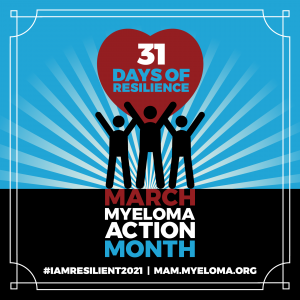
March is Multiple Myeloma Action Month. This blog series will feature facts about this blood cancer as well as voices from the myeloma patients and caregivers highlighting the resilience of this community.
Multiple myeloma is a cancer of the plasma cells found in the bone marrow. It makes up approximately 2% of all new cancer cases in the United States; more than 30,000 Americans are diagnosed each year.
Studies show an increased risk of diagnosis among veterans and first responders who are exposed to environmental toxins. Other risk factors include the presence of another plasma cell disease, family history, and obesity. Men are more likely to be diagnosed than women. Other people at higher risk than those in the Black population.
Among Black, multiple myeloma is the most common blood cancer. In fact, the number of new cases in Black communities is increasing at twice the rate of White communities. By 2034, it is estimated that Blacks will account for nearly a quarter of all newly diagnosed multiple myeloma patients.1
Blacks develop myeloma at an average age of 66, compared to age 70 in Whites, yet they may not be presented with the same healthcare options. Research shows that it typically takes longer for Black patients to be diagnosed compared to Whites, even though Black patients have a higher incidence of conditions linked with the development of myeloma (including monoclonal gammopathy of undetermined significance, or MGUS). Often, primary care physicians do not immediately test for myeloma since a patient can exhibit common symptoms, such as bone pain, fatigue, and kidney problems.
Unfortunately, Black myeloma patients continue to experience worse clinical outcomes than White patients. While overall patient survival rates have improved due to treatment advances, new medication classes and greater awareness of the disease, multiple myeloma is still twice as deadly in Blacks than in Whites. These outcomes can be attributed to significant disparities in access to healthcare, and social factors including employment status, poverty, housing, and transportation.
Racial disparities in healthcare are not limited to myeloma; they are entrenched and pervasive. As we have witnessed during the COVID-19 pandemic, Black and Latinx people are two to three times more likely to become infected with and die from the virus than White people. The reasons are varied, including socioeconomic status, lack of insurance, and more people of color working in higher risk, “essential” frontline jobs, such as in grocery stores or on public transit.
This March, in honor of Multiple Myeloma Awareness Month, we must commit to educating people of color and their caregivers about this incurable yet treatable disease. We must ensure that Black patients have the same access to cutting-edge treatment options that improve response rates and overall survival.
Already, the top myeloma advocacy and research organizations, such as the International Myeloma Foundation (IMF) and the Multiple Myeloma Research Foundation (MMRF), have prioritized expanding access to the Black community. They offer tools to help this population better recognize symptoms, understand their diagnosis, and research treatment options.
We should also expand access to and provide education about clinical trials. Although African Americans comprise 20% of all multiple myeloma patients, they comprise less than 5% of patients in myeloma clinical trials. Experts have identified multiple reasons for these low rates of participation, including mistrust of the medical establishment, cost, time commitment, lack of transportation, and family issues.
There is a bright spot in all of this. Research shows that when African American myeloma patients receive equal access to care, they achieve similar — if not better — outcomes than their White counterparts. Each day, researchers are dedicated to finding new, innovative ways to beat myeloma. And ongoing advances in myeloma care mean that people with myeloma are living longer than ever. It’s time for African Americans to reap the same benefits as other myeloma patients.
The Philadelphia Multiple Myeloma Networking Group (PMMNG), has committed to increasing participation by African American patients and their family members in our free monthly programs (held virtually during the pandemic). These meetings feature medical experts, financial advisors, oncology social workers, and other specialists who provide information about living with myeloma, treatment approaches, clinical trials, tips for financial assistance, and tools to promote well-being. We’d love for you to join us! Learn more about PMMNG and our meetings here.
1 https://ashpublications.org/blood/article/125/2/410/34257/Future-distribution-of-multiple-myeloma-in-the
Learn more about multiple myeloma here.
Find resources for more information here.